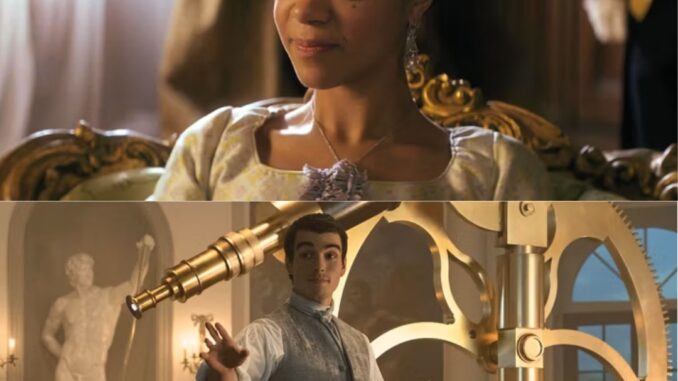
The series has always treated history as an inspiration, not a guide. The prequel is no exception.
Queen Charlotte: A Bridgerton Story has everything you love about a drama with Shonda Rhimes at the helm. Free from the strictures of Julia Quinn’s original series of Bridgerton novels, Rhimes has woven a rich tale about the young queen, her marriage to King George, her early friendship with a young Lady Danbury, and her relationship with her loyal servant Brinsley. The dialogue is quick and clever, and where Season 2 of Bridgerton was an amusement park of storylines and subplots, Queen Charlotte is focused, sharp, and smart. The costumes are dazzling, and deserve their own viewing in order to appreciate the care and brilliance of costume designers Lyn Elizabeth Paolo and Laura Frecon. Their work tells a story as rich and interesting as the script. On top of all this, India Amarteifio, as the young Charlotte, turns gracefully from girlish anger to fierce determination, and generates all the chemistry we want in such a show—not just with Corey Mylchreest, who plays her husband, King George III, but with Arsema Thomas, the young Lady Danbury, as well. It’s easy to imagine them as friends.
The season’s brilliance lies not just in what happens over the course of the six episodes, but in the questions it reminds about race, regency, and representation in popular culture as a whole. Queen Charlotte is a prequel story for a quasi-historical fictional universe in which Britain’s aristocracy is multiracial—a fact that prompted a fair amount of confused conversation about “color-blind” casting and adaptations of historical fiction when the first two Bridgerton seasons came out . In explaining this universe, the new prequel answers some of these questions—while, inevitably, raising a few new ones.

The first voice we hear as the season opens is the Bridgerton universe’s gossip columnist, Lady Whistledown (played by Julie Andrews). She gives us instruction and, perhaps, permission to accept that the story we are about to enter is drawn from history, without wondering too much about the details. She tells us that this is the story of Queen Charlotte from Bridgerton, by which she means that this is not the Queen Charlotte of history. That Queen Charlotte lived through the Haitian Revolution, the Napoleonic wars, and the abolition of the slave trade in Britain. Jane Austen—who I think would have loved Queen Charlotte for its wit and clear-eyed view of love and marriage as more about duty than fancy—died the year before the historical monarch. The series barely gestures toward this history. It is not, as Lady Whistledown tells us, a history lesson. It is a fantasy world created by writers facing the challenge of how to include Black characters in a historical period, without placing the weight of a fraught real-world history on those characters’ collective backs. Is it possible to set a romance of any kind against the backdrop of the slave trade (which seems not to exist in Queen Charlotte) and debates about abolition? Is it reasonable to expect this of a series that is for Netflix and not, say, PBS?
Queen Charlotte provides the backstory for Lady Danbury’s claim in Season 1 that the Black side of the ton—that is, the set of aristocrats who socialize and intermarry with one another—were elevated to that status because Queen Charlotte and King George fell in love. Their marriage, we find out in Queen Charlotte, launched the Great Experiment, an effort to create a court diverse enough to make a Black queen seem less scandalous. For those of us who know history, the fraught relationship between the young Black queen and her mother-in-law, Princess Augusta (Michelle Fairley), makes perfect sense. White women certainly suffer under British imperial patriarchy, but they also benefited from access to power and enjoy the status afforded them as white women whose paleness held cultural value. Princess Augusta wields her power ruthlessly—even if occasionally, along the way, she forwards social progress in the Bridgerton universe. You hate her for peering into the young queen’s mouth to check her teeth, and inspecting her hips, as if the young woman were on the auction block in a slave market. This inspection reminds viewers that no matter how opulent the gowns or glorious the jewelry, wealthy women were expected to reproduce empire. They were passed on from sons and fathers to husbands they did not choose. This is the reality that sets the season in motion, with young Charlotte peeking through the door, watching her brother sign her life away.
As always with Bridgerton, the costumes and settings create a historical milieu of their own. A major task faced by actresses Amarteifio and Thomas is to successfully deliver Shonda Rhimes’ long speeches without sounding as if they are giving one of Shonda Rhimes’ long speeches.
